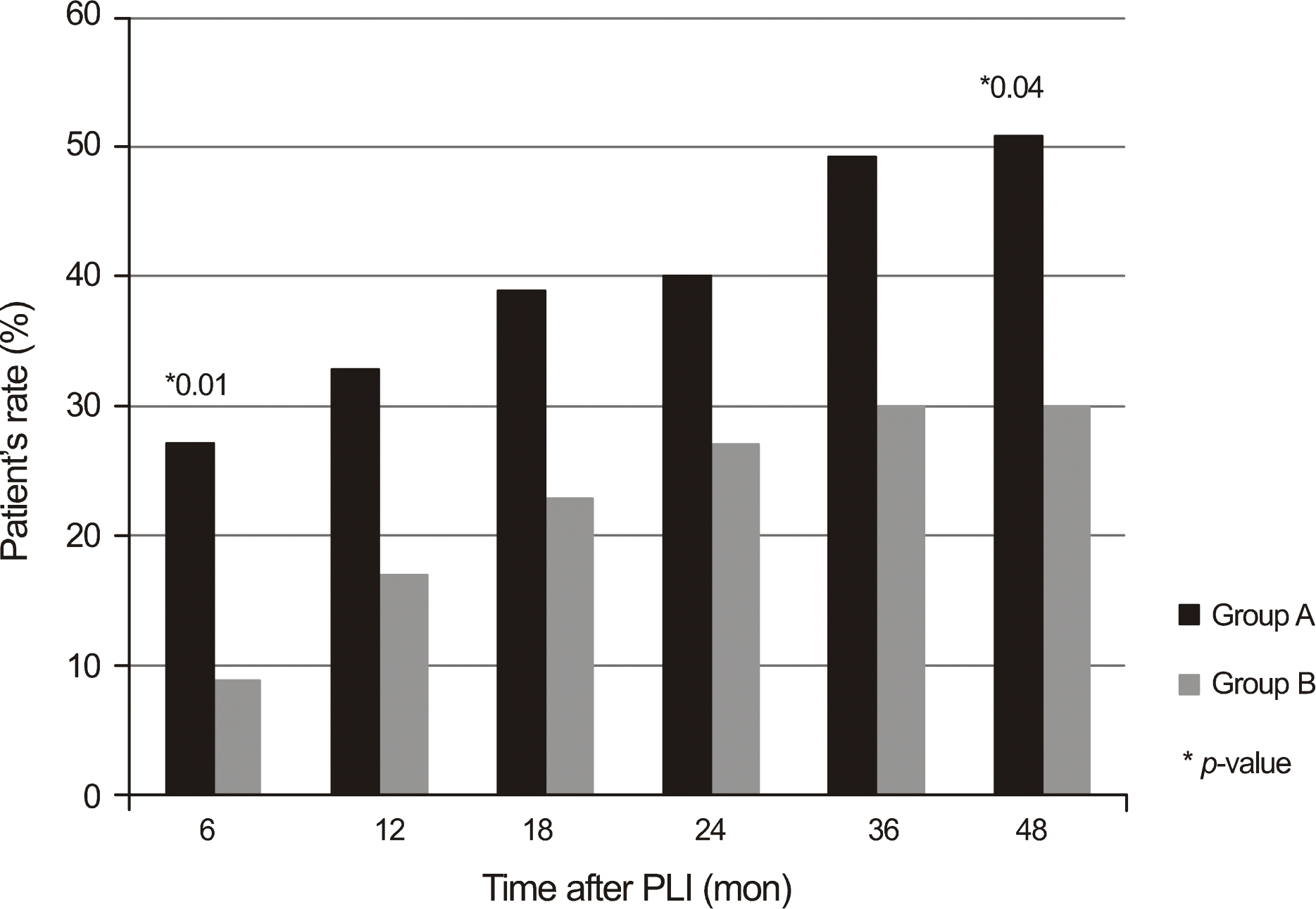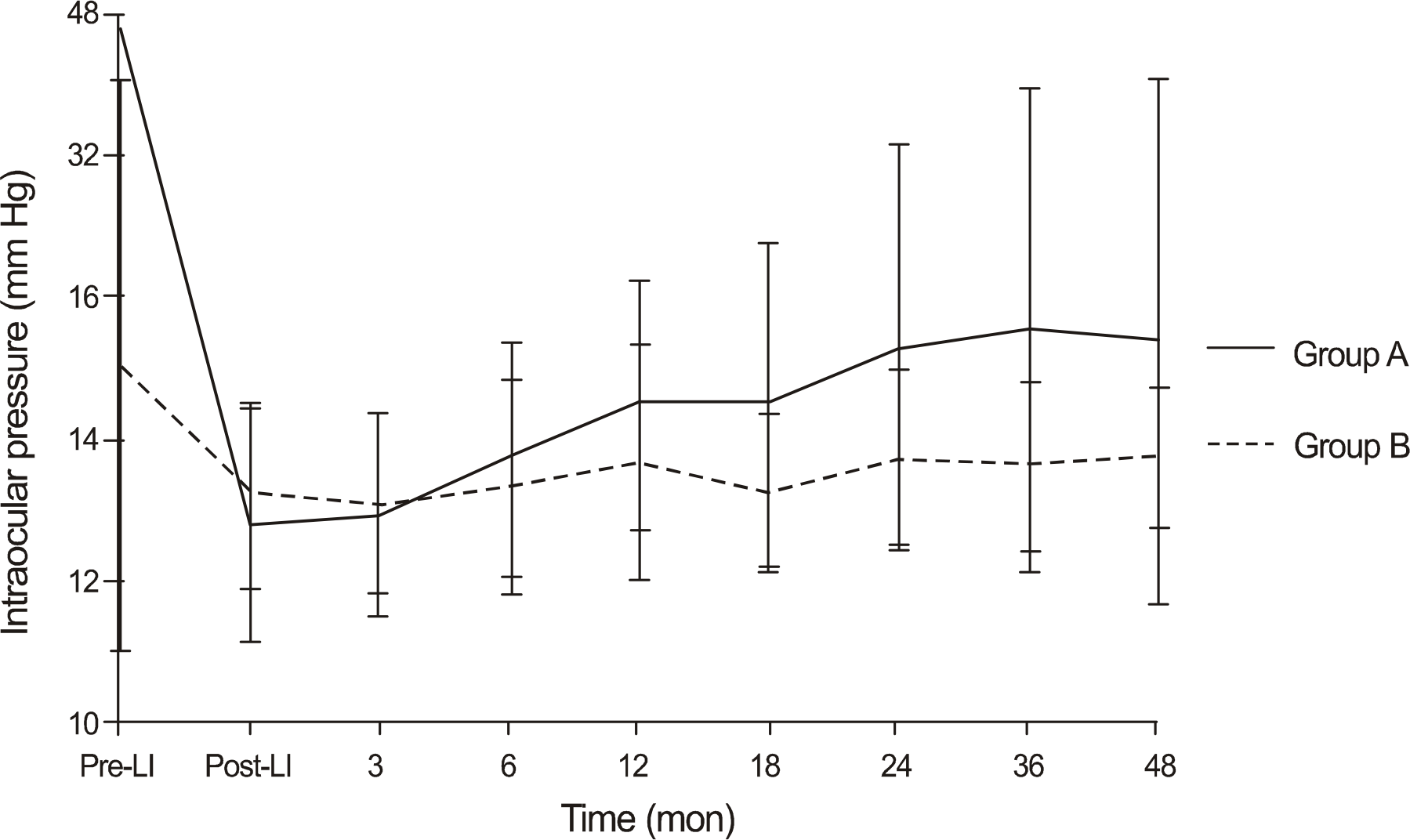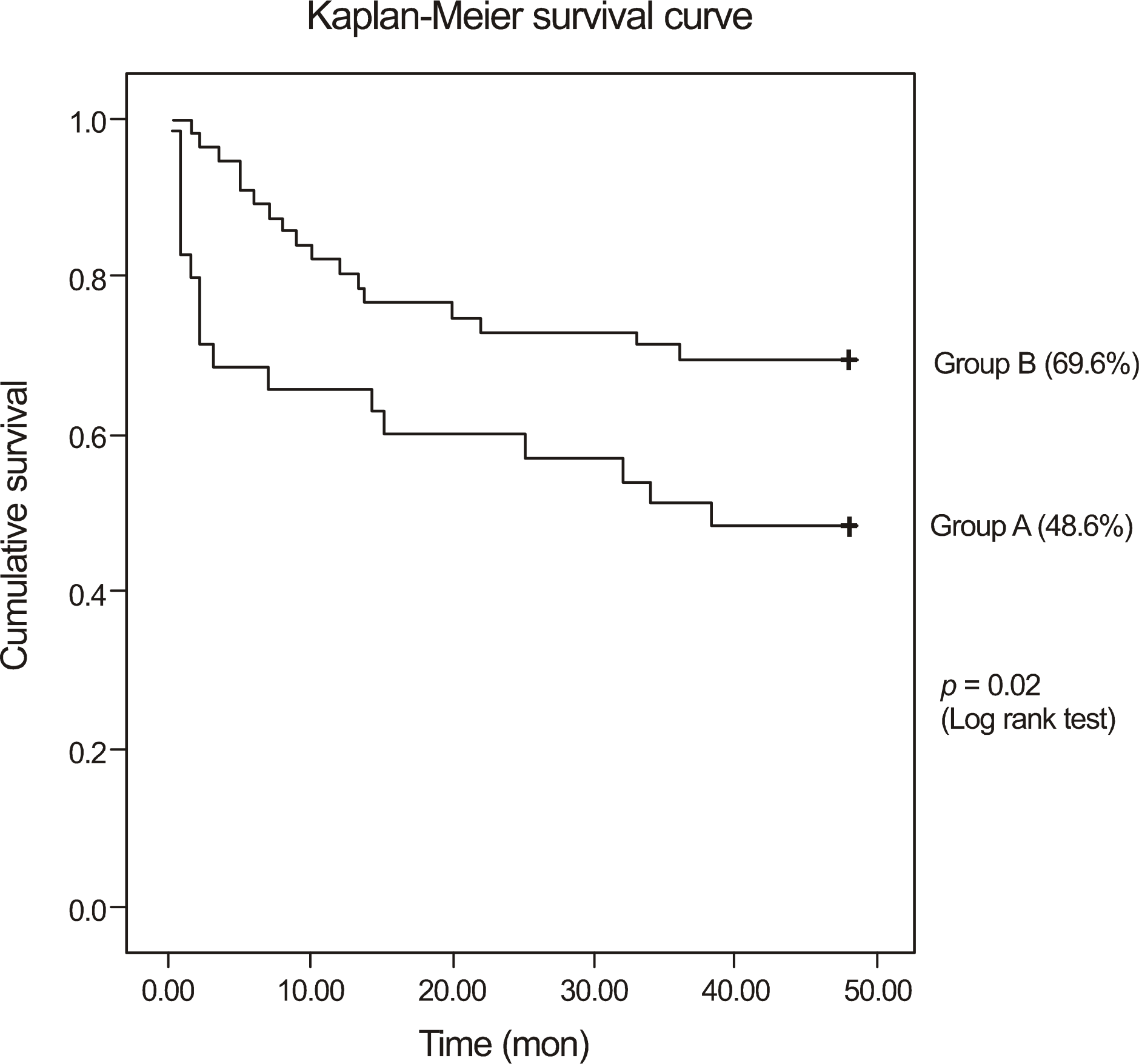Abstract
Purpose
To investigate the long-term effects of maintenance of intraocular pressure (IOP) after peripheral laser iridotomy (PLI) in patients with closed angle.
Methods
The patients who received PLI were assessed and divided into 2 groups. There were 38 patients (41 eyes) with a history or ocular findings of acute angle-closure attack in Group A, and 54 patients (70 eyes) who underwent prophylactic PLI in Group B. IOP over 18 mm Hg was considered to be re-elevated. The number of patients with re-elevated IOP and the duration until the re-elevation was investigated.
Results
The amount of IOP elevation immediately after PLI at 6, 24, and 48 months was 0.9, 2.5, and 2.6 mm Hg in Group A, and 0.1, 0.5, 0.5 mm Hg in Group B, respectively. The IOP re-elevation rate was 26.8, 40.0, and 51.4% at 6, 24, and 48 months in Group A and 8.6, 27.2, and 30.4% in Group B with statistically significant difference (p = 0.02, log-rank test).
Conclusions
Close, long-term observation for patients who receive PLI is recommended because there is a high risk of IOP re-elevation within 1 year after PLI. After prophylactic PLI, IOP was maintained under 18 mm Hg for a longer period than after acute angle-closure attack, thus performing preventive PLI should be considered.
Go to : 
References
1. Shin SG, Ahn JH, Rho SH. A clinical analysis on 456 cases of glaucoma among outpatients during 5 years. J Korean Ophthalmol Soc. 1987; 28:1201–6.
2. Kim DG, Kim HJ, Song MS. Clinical study on glaucomatous patients. J Korean Ophthalmol Soc. 1990; 31:1174–9.
4. Krupin T, Mitchell KB, Johnson MF, Becker B. The long-term effects of iridectomy for primary acute angle-closure glaucoma. Am J Ophthalmol. 1978; 86:506–9.

5. Lee HB, Hwang US, You JM, Song JK. Sequential argon and Nd: YAG laser iridotomies in angle closure glaucoma. J Korean Ophthalmol Soc. 1999; 40:2245–51.
6. Alsagoff Z, Aung T, Ang LP, Chew PT. Long-term clinical course of primary angle-closure glaucoma in an Asian population. Ophthalmology. 2000; 107:2300–4.

7. Salmon JF. Long-term intraocular pressure control after Nd-YAG laser iridotomy in chronic angle-closure glaucoma. J Glaucoma. 1993; 2:291–6.

8. The Advanced Glaucoma Intervention Study (AGIS): 7. The relationship between control of intraocular pressure and visual field deterioration. The AGIS Investigators. Am J Ophthalmol. 2000; 130:429–40.
9. Dueker D. Ciliary-block glaucoma-differential diagnosis and management. J Glaucoma. 1994; 3:167–9.

10. Aung T, Ang LP, Chan SP, Chew PT. Acute primary angle-closure: long-term intraocular pressure outcome in Asian eyes. Am J Ophthalmol. 2001; 131:7–12.

11. Lee HJ, Kim JH, Sohn YH. Long-term intraocular pressure change in attacked and fellow eyes with acute angle-closure glaucoma after laser iridotomy. J Korean Ophthalmol Soc. 2004; 45:1298–303.
12. Lichter PR, Musch DC, Gillespie BW, et al. Interim clinical outcomes in the Collaborative Initial Glaucoma Treatment Study comparing initial treatment randomized to medications or surgery. Ophthalmology. 2001; 108:1943–53.

13. Heijl A, Leske MC, Bengtsson B, et al. Reduction of intraocular pressure and glaucoma progression: results from the Early Manifest Glaucoma Trial. Arch Ophthalmol. 2002; 120:1268–79.
14. Chung JH, Park JS, Choi YI. Long-term intraocular pressure outcome after successful laser iridotomy for the acute primary angle-closure glaucoma. J Korean Ophthalmol Soc. 2003; 44:1102–6.
15. Snow JT. Value of prophylactic peripheral iridectomy on the second eye in angle-closure glaucoma. Trans Ophthalmol Soc U K. 1977; 97:189–91.
Go to : 
 | Figure 3.Patients rate whose intraocular pressure was re-ele-vated after peripheral laser iridotomy (PLI). |
Table 1.
Baseline characteristics
| Group A | Group B | p-value | |
|---|---|---|---|
| Age (mean ± SD, yr) | 62.0 ± 8.7 | 61.7 ± 9.6 | 0.849* |
| Sex (number of eyes) | 41 | 70 | 0.638† |
| Male | 11 | 16 | |
| Female | 30 | 54 | |
| Mean duration of follow-up (mean ± SD, mon) | 58.2 ± 43.3 | 46.4 ± 28.1 | 0.124* |
Table 2.
Pre- and Post-PLI intraocular pressure (mean ± SD)
|
Intraocular pressure (mm Hg) |
p-value | ||
|---|---|---|---|
| Pre-PLI | 1 wk after PLI | ||
| Group A (n = 41) | 46.8 ± 18.0 | 12.8 ± 3.3 | 0.001* |
| Group B (n = 70) | 15.1 ± 8.1 | 13.2 ± 2.6 | 0.061* |
Table 3.
Time duration until re-elevation in patients whose IOP was reelevated
| Group A (n = 18) | Group B (n = 17) | p-value | |
|---|---|---|---|
| Time duration (mon) | |||
| Mean ± SD | 10.0 ± 13.2 | 12.2 ± 10.2 | 0.089* |
| Range | 0.3-38.4 | 1.5-36.0 |




 PDF
PDF ePub
ePub Citation
Citation Print
Print




 XML Download
XML Download